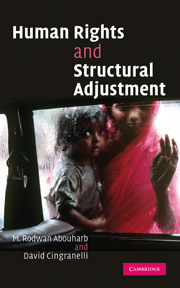Book contents
- Frontmatter
- Contents
- List of figures
- List of tables
- Acknowledgments
- Part I The argument
- Part II Estimating the human rights effects of structural adjustment
- Part III Findings
- 6 Economic and social rights
- 7 Civil conflict: demonstrations, riots, and rebellion
- 8 Torture, murder, disappearance, and political imprisonment
- 9 Worker rights
- 10 Democracy and civil liberties
- Part IV Conclusion
- Bibliography
- Author index
- Subject index
6 - Economic and social rights
Published online by Cambridge University Press: 30 June 2009
- Frontmatter
- Contents
- List of figures
- List of tables
- Acknowledgments
- Part I The argument
- Part II Estimating the human rights effects of structural adjustment
- Part III Findings
- 6 Economic and social rights
- 7 Civil conflict: demonstrations, riots, and rebellion
- 8 Torture, murder, disappearance, and political imprisonment
- 9 Worker rights
- 10 Democracy and civil liberties
- Part IV Conclusion
- Bibliography
- Author index
- Subject index
Summary
Introduction
In 2000, the World Bank and IMF, the Organisation for Economic Co-operation and Development, and the United Nations published a jointly prepared document titled A Better World for All. In it, the world's two most important international financial institutions guaranteed that, in partnership with others, they would make substantial progress in reducing world poverty by 2015. The report proposes measuring poverty reduction in seven areas: world poverty (the percentage of people living on the equivalent of 1 US dollar or less per day), gender gaps in school enrollment, primary school enrollment, infant mortality and maternal mortality (Sadasivam 1997), access to health services, and sustainable development. Among other specific goals mentioned in the report, the promises include decreasing rates of infant mortality by two-thirds and maternal mortality by three-fourths, providing access to all that need health services, and ensuring that all children are enrolled in primary school. Taken together, the goals in the report are commonly referred to as the “Millennium Development Goals.”
This report and these promises made in it were necessary because there is a growing consensus that most of the countries we usually refer to as “developing economies” are not developing at all or are not developing as quickly as had been hoped. Jeffrey Sachs, an economist who directs the Millennium Development Project, notes that, according to World Bank estimates, 1.1 billion people or about one-sixth of the world's population live in extreme poverty (Sachs 2005).
- Type
- Chapter
- Information
- Human Rights and Structural Adjustment , pp. 135 - 149Publisher: Cambridge University PressPrint publication year: 2007



